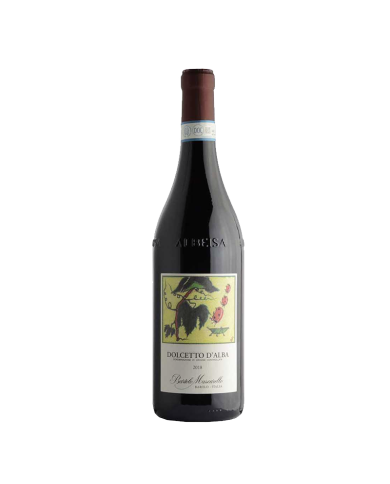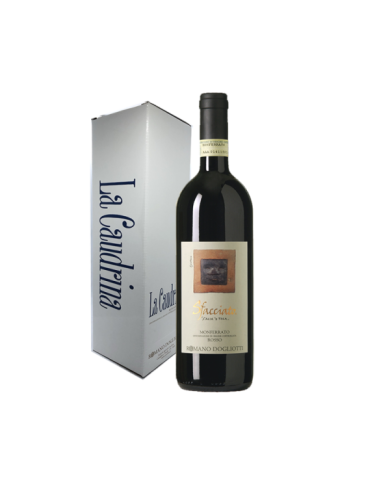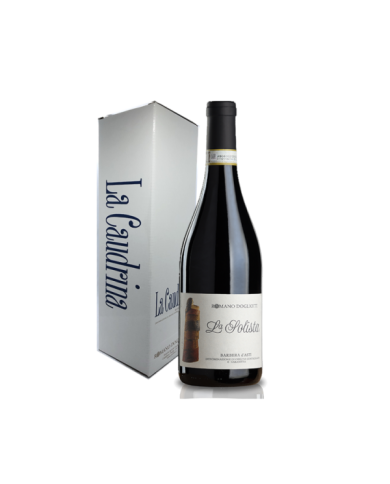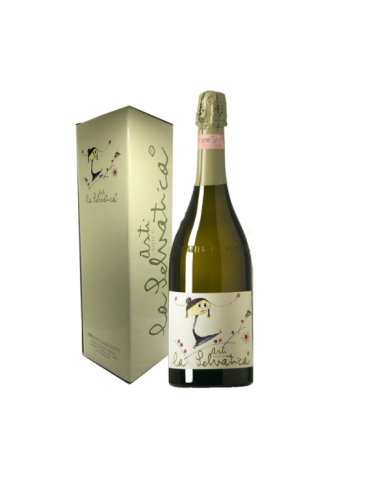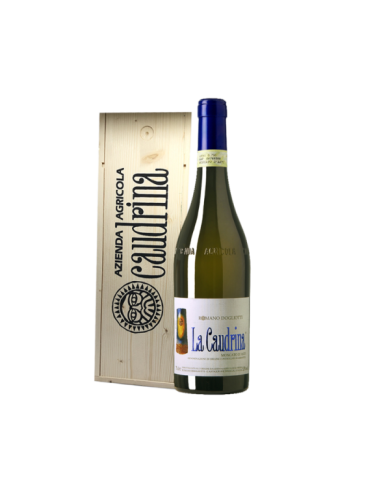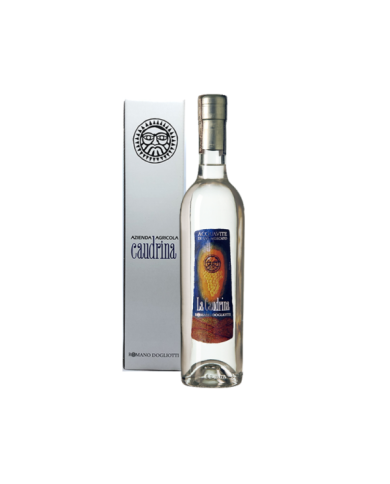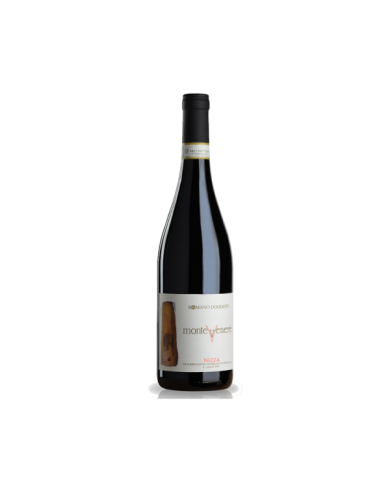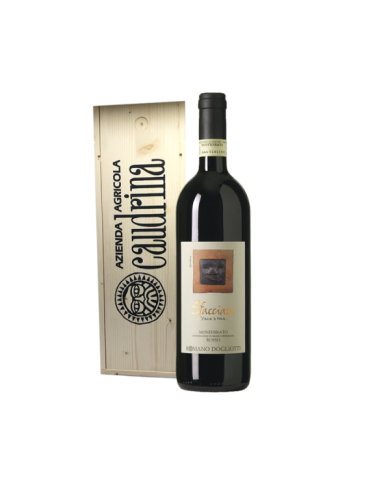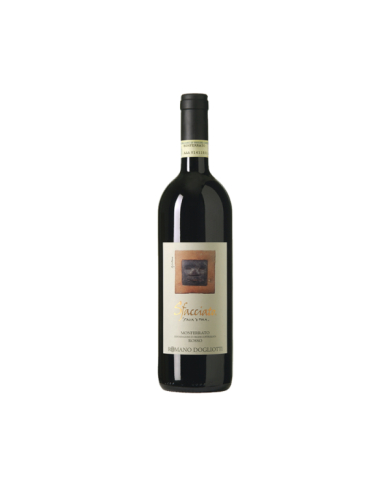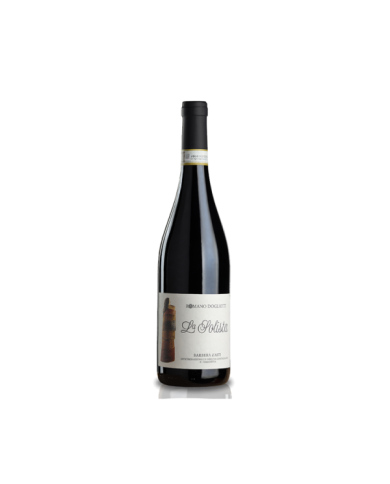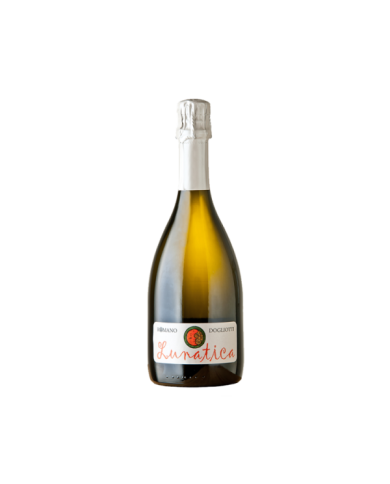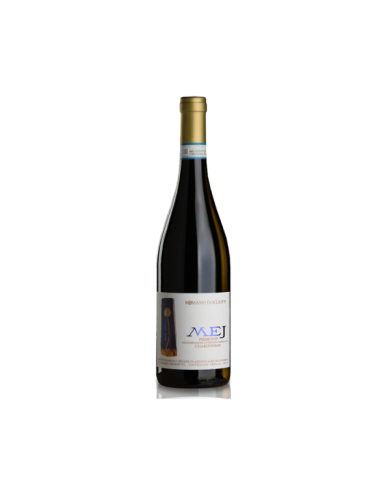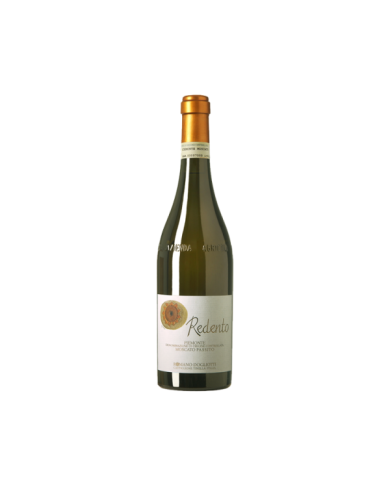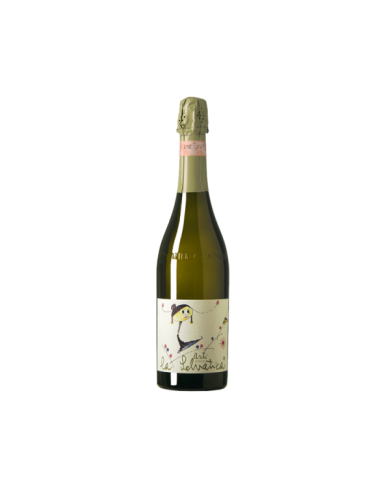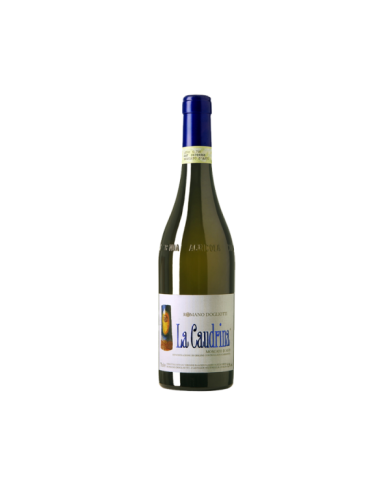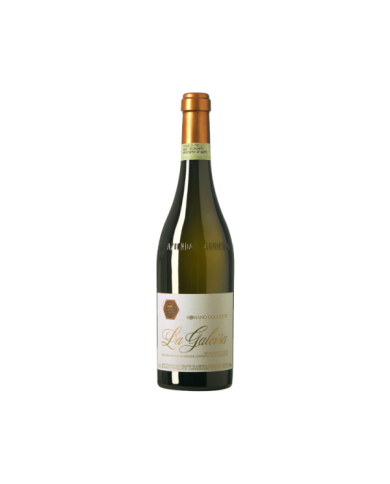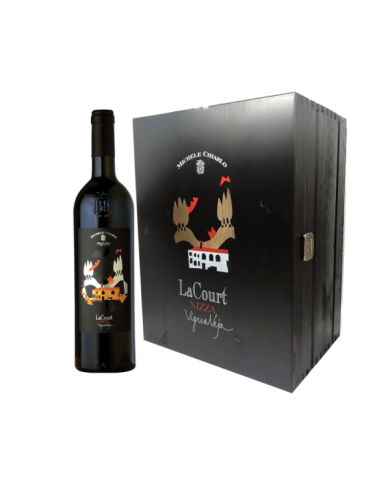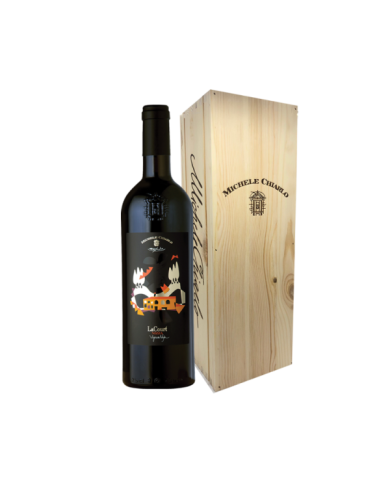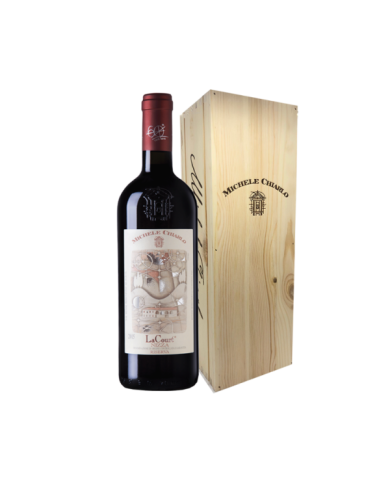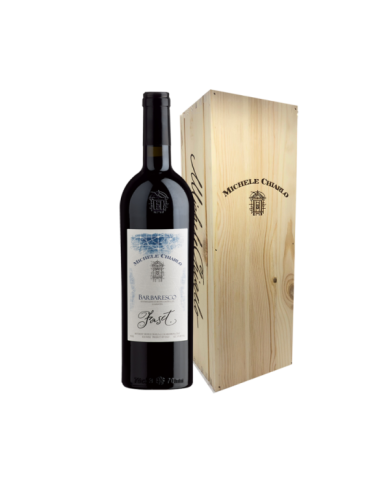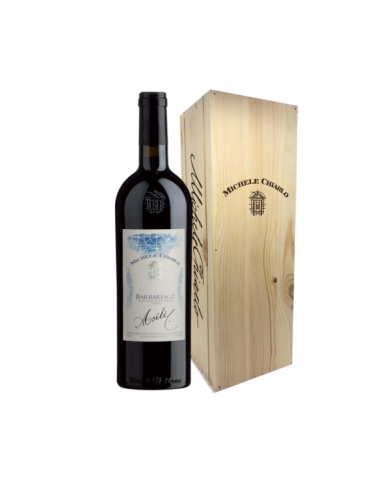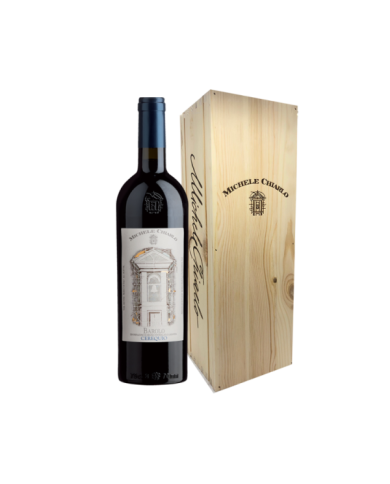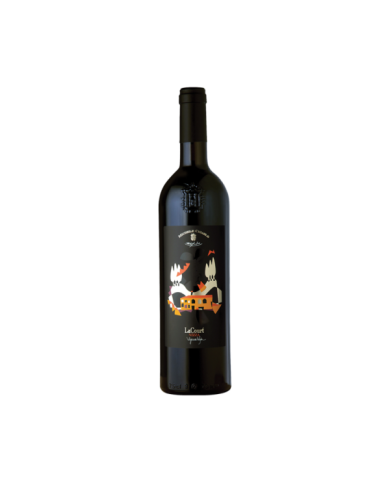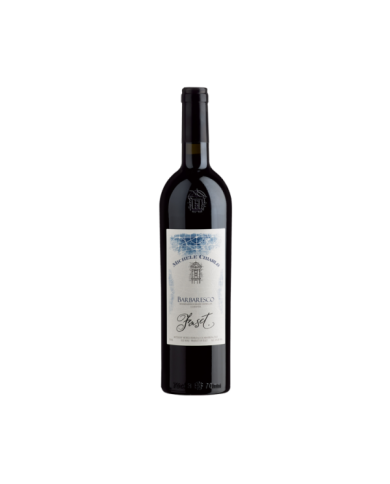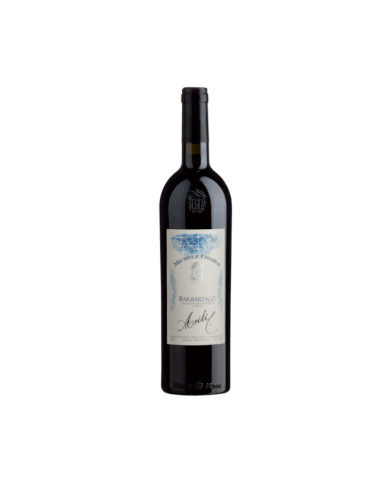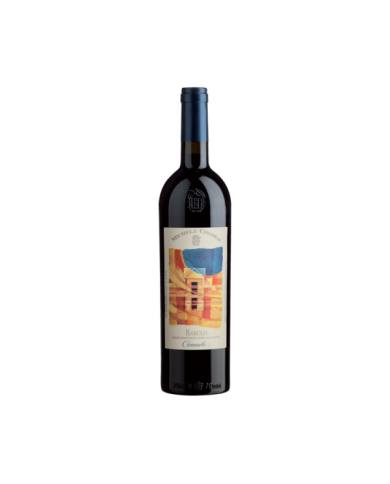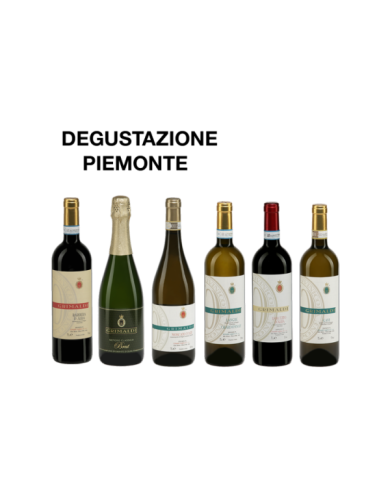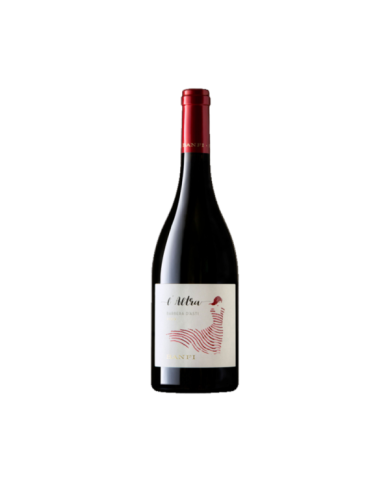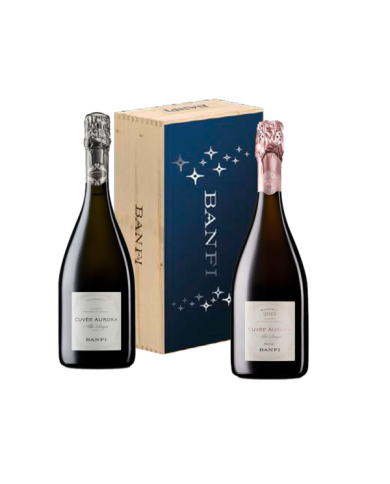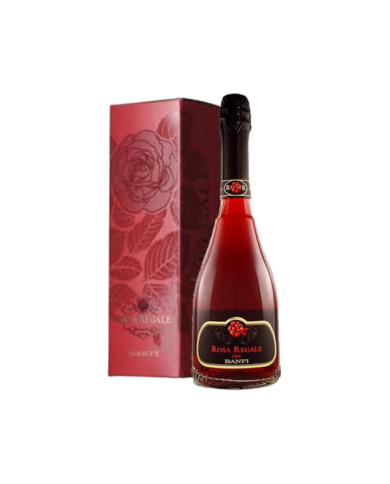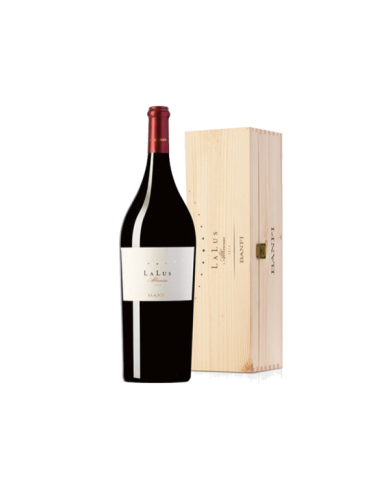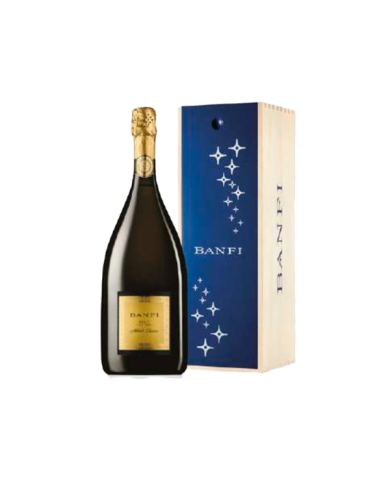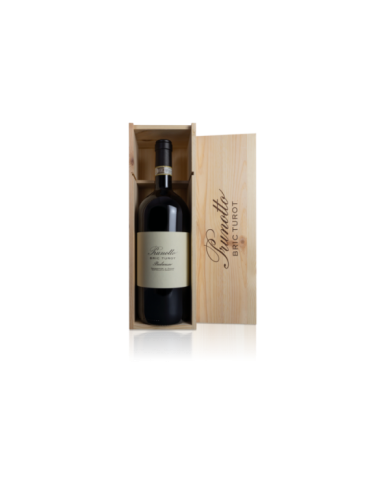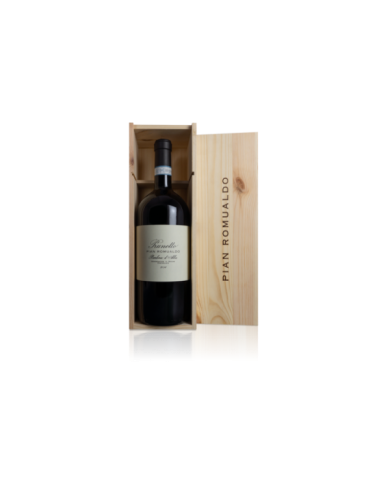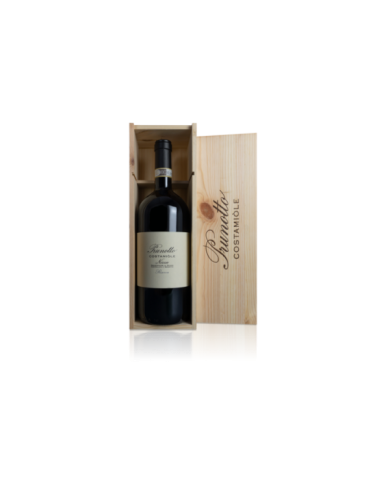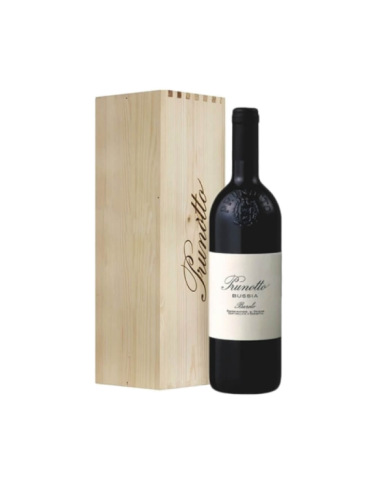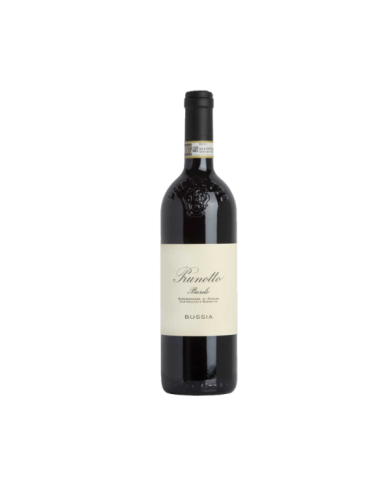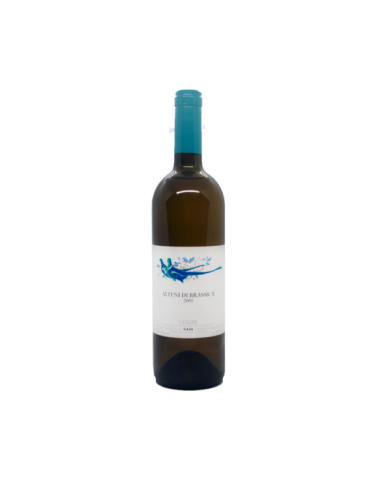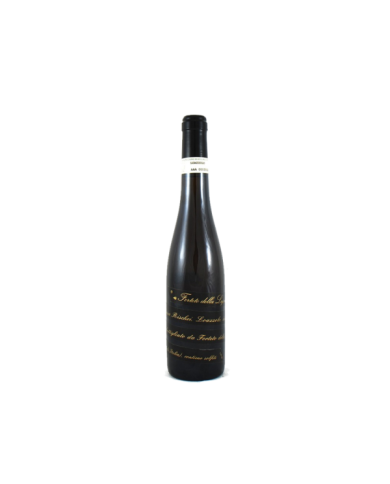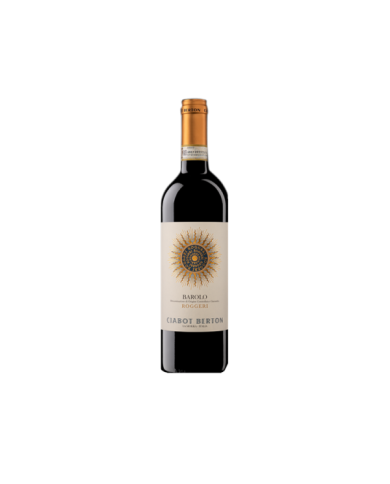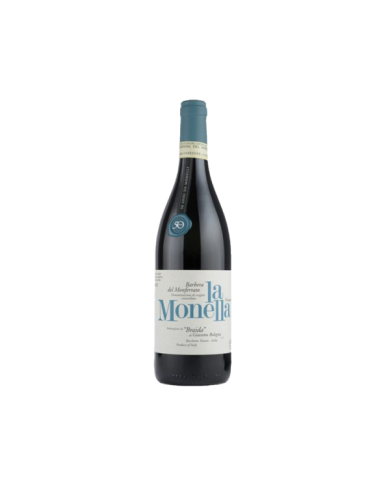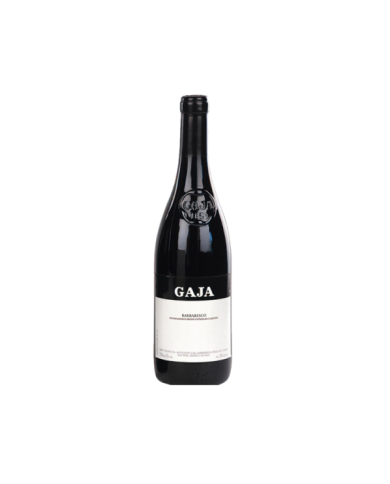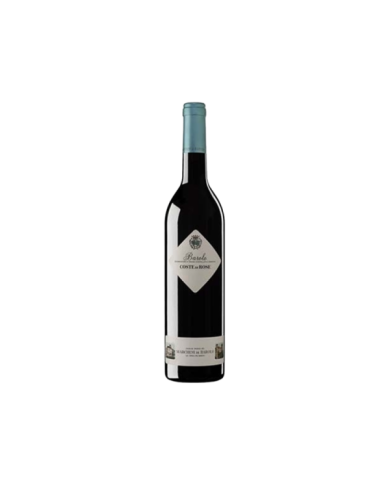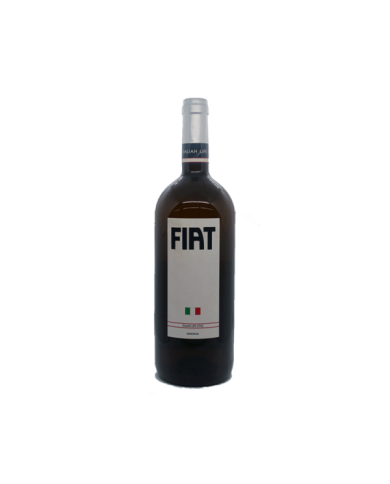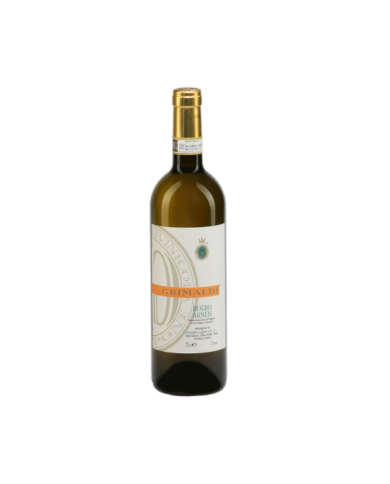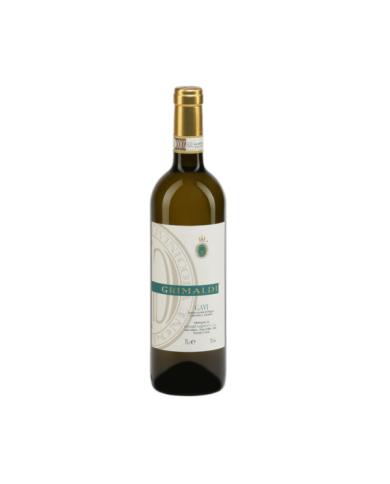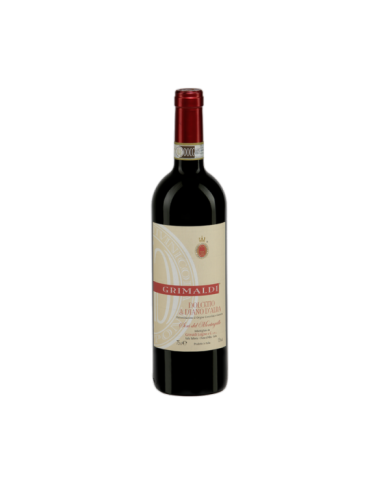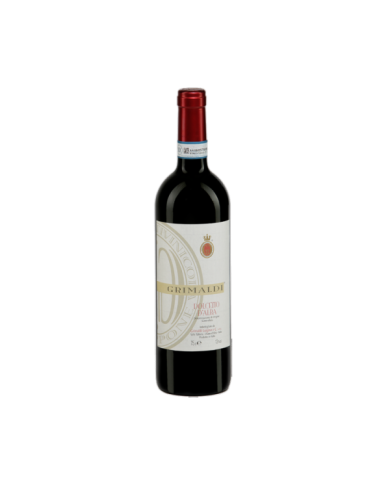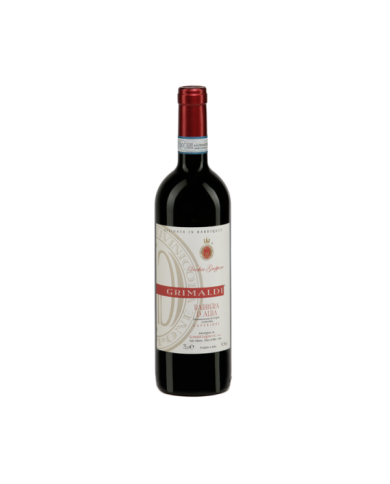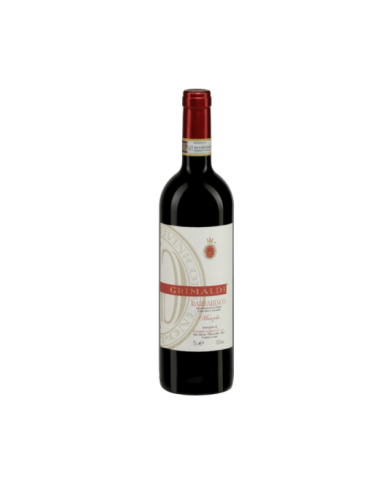Bartolo Mascarello , Dolcetto d'Alba 2020 is an explosive wine with marked notes of red fruits, earth, wild herbs. Robust and rustic wine without giving up the finesse, a milestone characteristic of the Mascarello Bartolo winery. Bartolo Mascarello Dolcetto d 'Alba is a deep and intensely aromatic red, with a deep ruby color. The nose offers a greedy and persistent bouquet with refined aromas of violet and lavender mixed with black cherry and sweet spices. On the palate it offers a wide range of flavors, with a prevalence of fruit and then strokes of rosemary and thyme. Its delicate acidity is refreshing and perfectly integrated.
Asti Spumante "La Selvatica" is a sweet sparkling wine made from Moscato grapes, characterized by good body and beautiful vivacity. Rich and inviting scents of fruit evoke seductive and fairytale scenarios. On the palate it reveals aromatic complexity and a rich and fresh sweetness
The Moscato d'Asti from the La Caudrina winery is a delicate, fresh and immediate sparkling sweet wine. It comes from almost 40-year-old vines at 280 m above sea level and is expressed in an engaging aromatic range rich in fruit and flowers. The grapes that give rise to Moscato d'Asti La Caudrina are hand-picked and gently pressed. The must thus obtained is subjected to clarification and filtration, after which it is placed in refrigerated tanks. Fermentation takes place in an autoclave, to preserve liveliness and effervescence.
This wine was made from grapes from its own vineyards located in the municipality of Nizza Monferrato in the Bricco region. The grapes are pressed whole immediately after harvesting and the must made clear by clarification. The following day the yeasts are inoculated for the first fermentation which lasts about 30 days at a temperature of 15 ┬░ C. The wine rests for about three months on the lees, after which the second inoculation of yeasts takes place for the second fermentation which will last. for about 40 days. At this point the wine is filtered and prepared for bottling.
This wine was made from grapes from its own vineyards located in the municipality of Nizza Monferrato . The de-stemmed grapes were pressed after a cold maceration of about 24 hours, the flower must obtained was placed in temperature-controlled tanks where alcoholic fermentation took place at a temperature of 18-20 ┬░ C. A finished sprint remains in the lees for about 3 months. After this period, the wine, with a small part of lees, continues its maturation in small French oak barrels where it remains for a few months.
After drying, the grapes are pressed and the must obtained, after a first racking, is left to ferment with the use of special selected yeasts . The must ferments at a low temperature, about 15 ┬░, until it has developed about 12 degrees of alcohol. Subsequently, the cleaned and filtered wine is placed in barriques for refinement, during which there is a slight fermentation recovery. Refinement lasts approximately 18 months . After this period the wine was filtered and bottled to be further refined in the bottle for about 6 months .
Asti Spumante "La Selvatica" is a sweet sparkling wine made from Moscato grapes, characterized by good body and beautiful vivacity. Rich and inviting scents of fruit evoke seductive and fairytale scenarios. On the palate it reveals aromatic complexity and a rich and fresh sweetness
Muscat grapes, aromatic par excellence, require a particular vinification technique to preserve all the fragrance of the fruit in the wine. Immediately after the harvest, rigorously by hand , the grapes are gently pressed and the must obtained is made brilliant with clarification and filtration. This grape juice is kept in refrigerated tanks until it is processed in an autoclave to obtain a lively wine by means of a fermentation conducted at a controlled temperature with the use of selected yeasts. the production process is identical for the different muscatels even if each of them has particular qualitative characteristics, conferred by the different vineyards of origin .
Beautiful wooden box consisting of 2 bottles: 1 CUV├ēE AURORA ROS├ē Alta Langa DOCG Classic Method 2016 1 CUV├ēE AURORA Alta Langa DOCG Classic Method 2016
Sweet sparkling wine obtained from the Brachetto vine, an ancient and complex aromatic grape present only in the Acquese area, characterized by unique and inimitable aromas. The cold maceration of the fruits and the subsequent soft pressing allow the extraction of the intense typical aromas contained in the peel and the characteristic pale ruby red color. A pleasant wine, extraordinarily elegant.
Thanks to a very careful selection of the grapes, this Cuv├®e contains from season to season the maximum freshness that the Chardonnay, Pinot Nero and Pinot Bianco vines are able to express. A classic from Banfi .
Prestigious label from the Prunotto winery of the Piedmont region. The certified classification is the DOCG one which guarantees its origin. The variety of grapes used for its vinification is, as required by regulations, that of 100% pure Nebbiolo .
Nebbiolo "Occhetti" comes from an alcoholic fermentation in steel of carefully selected grapes, from an average maceration of 7 days and, finally, from an aging in large barrels for 14 months and in bottle for 4 months. It has a fine ruby red color, with a hint that is already visibly garnet. Time knows how to appreciate this extraordinary Nebbiolo very well. On the nose there are notes of small ripe red fruits of the undergrowth, cherry jam, licorice, delicate spices. An excellent balance. On the palate the wine is harmonious, soft, with pleasant tannins and a long and exciting finish. A Nebbiolo with great personality.
A prestigious label from the Prunotto winery. It boasts the classification of Barolo DOCG. The highest honor. It is produced with 100% pure Nebbiolo grapes as required by the strict disciplinary. The vinification foresees that the grapes, selected in the vineyard and de-stemmed, are immediately pressed. Maceration lasted about 15 days, at a maximum temperature of 30 ┬░ C. The malolactic fermentation ended before the end of winter. This is followed by a long period of aging for 24 months in oak barrels of different capacities (27-53-77 Hl) which give the wine maturity and balance. The further refinement in the bottle lasted 12 months and took place in the Prunotto cellars before being shipped to the market. The Bussia vineyard resides in the Municipality of Monforte at an altitude of 350 meters above sea level. It is exposed to the South. The soils are from the Tortonian period and are characterized by the presence of S. Agata marls and fossils. Rich is the presence of compact limestone clays alternating with sandy layers.
A prestigious label from the Prunotto winery . It boasts the classification of Barolo DOCG. The highest honor. It is produced with 100% pure Nebbiolo grapes as required by the strict disciplinary. The color is intense garnet red with ruby reflections. Aroma of very ripe stone fruit well blended with floral and spicy notes. Intense flavor with sweet and enveloping tannins with a long aftertaste.
The Fiat Chardonnay bottle can be a gift idea for passionate motorists. Automotive design wines produced in limited numbers by the eccentric Piedmontese producer Pier Giorgio Scrimaglio . + long Fiat heritage apron.
Forteto della Luja Loazzolo is a fragrant and enveloping wine, with a deep yellow color with apricot and gold reflections. The olfactory profile reveals a rich, ripe fruit, with a prevalence of apricot notes. The "muscat" root of the fruit is evident, which a balsamic wood enriches with spicy and roasted notes. Rich and creamy on the palate, to which it unfolds in all its multifaceted sweetness and alcohol, with interesting returns of fruit, chocolate and honey. A very pleasant wine, which ends long, with an echo of vanilla and white chocolate. Constitutionally long-lived, it maintains an enviable gustatory balance for many years. Excellent meditation wine, it goes well with aged cheeses and desserts.
Barbera del Monferrato was born in some territories of the provinces of Asti and Alessandria entirely dedicated to the cultivation of Barbera grapes, one of the symbols of Piedmont and of Italian viticulture. In Monferrato both immediate and drinkable expressions and intense and elegant interpretations are born. The latter can be called Superiore if they benefit from aging in oak barrels for at least 6 months. These are high quality red wines, inseparable companions of good food.
For four generations, the Grimaldi family has cultivated the best vineyards of Langhe and Roero, bottling the most prestigious denominations of the area: Barolo, Barbaresco, Nebbiolo d'Alba, Dolcetto di Diano d'Alba and Dolcetto d'Alba, Barbera d'Alba, Roero Arneis, Gavi, Moscato d'Asti and Langhe Chardonnay.
The Fiat Chardonnay bottle can be a great gift idea for car enthusiasts. Wines with an automotive design produced in limited numbers by the eccentric Piedmontese producer Pier Giorgio Scrimaglio. The Scrimaglio family has been in Piedmont since the 17th century and comes from France, where it bore the name Escrimeaux (swordsman). In Monferrato, it gave its name to an area that is still called Region Scrimaglio, where the farm and vineyards are now located. Francesco Scrimaglio, the progenitor of the family, started his wine-growing business in the early 1900s, which was later expanded by his son Pietro and grandsons Franco and Mario.
Barolo Chinato is by definition an aromatized wine and is obtained by mixing ethyl alcohol with sugar and Barolo DOCG .
Color : deep and brilliant straw yellow Bouquet : intense and floral with final notes of acacia flowers, with fine and persistent perlage Taste : pleasantly fresh and elegant with intense notes of yeast, bread crust and honey, with good structure and persistence Tasting temp . : 6 - 8 ┬░ C Pairings : it is an excellent aperitif and with shellfish, but it goes very well with all dishes, especially fish
Color : intense and brilliant straw yellow with greenish reflections Bouquet : intense and fruity with hints of tropical fruit and apples Taste : with good structure and balance, dry and pleasantly fresh and savory Tasting temperature : 8 - 10 ┬░ C Pairings : appetizers and fish dishes
Color : intense and brilliant straw yellow with greenish reflections Taste : dry, harmonious, fresh and persistent, with mineral notes Tasting temperature: 8 - 10 ┬░ C Pairings : appetizers and fish-based dishes
Color : intense ruby red with garnet reflections Aroma : vinous, with hints of red fruits and cherries Taste : dry, harmonious and full-bodied, with great freshness and with final notes of almonds persistent in the aftertaste Tasting temp.: 16 - 18 ┬░ C Pairings: cured meats, first courses, poultry and white meats
Color : ruby red with violet reflections Bouquet : intense and vinous with hints of jam and spicy notes, dry and of great structure, harmonious and velvety Tasting temperature: 16 - 18 ┬░ C Pairings : roasts, spicy cheeses, raw meat, boiled and game
The refinement takes place in oak barrels and small barriques. It is then left to rest for a short time in the bottle. The wine has a beautiful garnet red color with orange reflections. The intense aroma recalls dried flowers and violets.
One of the best Barolos in Italy. This wine is produced from a careful selection of the best Nebbiolo grapes from the Vigna San Biagio vineyard in the municipality of La Morra.
Barolo Grimaldi
This wine comes from a careful selection of the best grapes from the vineyard of the Vigna Vecchia Groppone family, located in the municipality of Diano d'Alba.
Discover the magic of Piedmont wines: savor the taste of tradition!
Piedmont is one of the best known Italian regions for the production of excellent wines. Piedmont's winemaking tradition has developed over the centuries and the wines produced in the region are appreciated all over the world.
The origins of Piedmont wine
Piedmont wine has ancient origins. The region, located in the north-western part of Italy, has a temperate climate which lends itself to the production of quality wines. The first documents referring to the wines of Piedmont date back to the Middle Ages, when the princes of the region invited their guests to taste their wines.
Piedmont wine styles
Piedmont wine styles are very diverse. The best known wines are the red wines Barolo and Barbaresco, both based on Nebbiolo, a vine native to the region. Red wines from Piedmont are generally more full-bodied, with complex aromas ranging from berries to spices, and have good acidity which makes them suitable for ageing.
Besides red wines, Piedmont is also famous for its white wines, such as Gavi and Arneis . These wines are lighter and have less tannins than red wines, but are just as tasty.
What are the most famous Piedmontese wines?
The wines of Piedmont are appreciated all over the world and are considered among the best wines of Italy. Among the best known are Barolo, Barbaresco, Gavi, Arneis , Dolcetto and Barbera. These wines have been enjoyed by generations of wine lovers and are a must for anyone who wants to discover the winemaking tradition of Piedmont.
How to best savor the wines of Piedmont
The wines of Piedmont are wines to be tasted slowly. The tasting must be done in a quiet environment and with the use of glass glasses suitable for wine tasting. The serving temperature is essential to get the most out of the wine: white wines should be served cold (8-10┬║C) while red wines should be served at a higher temperature (16-18┬║C).
To better appreciate the wines of Piedmont, it is important to know the flavors and aromas of each wine. You should try to identify the aromas and flavors of each wine, such as berries, spices, herbs and earthy notes. This will help you better understand how wines pair with food and how to choose the most suitable wines for a given occasion.
Taste the tradition with the wines of Piedmont
Tasting the wines of Piedmont is a unique experience. It will let you discover the flavors and aromas of a millenary winemaking tradition that has made Piedmont one of the best-known places in the world for the production of quality wines.
Choose a wine from Piedmont and savor all the magic and taste of tradition!
Denomination Vini del Piemonte: A Journey Into the World of Wine
Piedmont is a region located in northwestern Italy that stretches from the Alps to the Po. This region is famous for its natural beauty, culture, history and, above all, for the production of high quality wines. In this guide, you will discover everything there is to know about the denomination of Piedmont wines, from the grape varieties to the main wines produced and their characteristics.
Introduction to the appellation of Piedmont wines
The denomination of wines of Piedmont is a system of classification of wines based on their origin, the variety of grapes used and the production methods. There are three levels of appellation for the wines of Piedmont: DOCG (Controlled and Guaranteed Designation of Origin), DOC (Controlled Designation of Origin) and IGT (Typical Geographical Indication).
IGT extension
The IGT is the lowest denomination and covers the entire Piedmont region. This appellation allows producers to use grapes from other regions and to experiment with new winemaking techniques. IGT wines can have very different characteristics, depending on the variety of grapes and the techniques used.
DOC
The DOC designation is reserved for wines produced in specific areas of Piedmont and which meet specific production criteria. These wines must be produced with a certain grape variety, they must be aged for a specific period and they must respect specific production criteria.
DOCG
The DOCG denomination is the highest in the hierarchy of the denomination of wines of Piedmont. This appellation is reserved for wines that represent the best of Piedmont and that have an international reputation. DOCG wines are produced in specific areas of Piedmont, using specific grape varieties and following strict production criteria.
The grape varieties of Piedmont
Piedmont is famous for its large variety of native grapes, some of which are used to produce some of the finest wines in the world. Here are some of the most important grape varieties of Piedmont:
Nebbiolo
Nebbiolo is Piedmont's most important grape variety and is used to produce some of the region's most famous wines, such as Barolo and Barbaresco. This grape variety is known for its fruity flavor and tannic character.
Barbera
Barbera is the second most important grape variety in Piedmont and is used to produce highly regarded red wines, such as Barbera d'Alba and Barbera d'Asti.
The main wines of Piedmont
Piedmont is famous for producing some of the finest wines in the world, which are known for their unique flavor and distinctive characteristics. Here are the main wines produced in the region:
Barolo
Barolo is the king of Piedmont wines and is produced with Nebbiolo grapes grown in the hills of the municipality of Barolo. This wine is famous for its fruity and complex flavour, its tannic character and its intense ruby red colour. Barolo is aged in wooden barrels for a minimum of three years and has an alcohol content of approximately 13%.
Barbaresco
Barbaresco is another great red wine from Piedmont produced with Nebbiolo grapes. This wine has a similar flavor to Barolo, but is a little softer and lighter. Barbaresco is aged for at least two years and has an alcohol content of around 13%.
Barbera d'Alba
Barbera d'Alba is a red wine produced with Barbera grapes and cultivated in the Langhe area. This wine has a fruity flavor and an alcohol content of approximately 12.5%. Barbera d'Alba is aged for at least one year in wooden barrels.
Moscato d'Asti
Moscato d'Asti is a sweet white wine produced with white Moscato grapes grown in the Langhe area. This wine has a fruity and fresh taste and is perfect as an aperitif or dessert. Moscato d'Asti has an alcohol content of approximately 5%.
Piedmont is a very important wine region that offers some of the finest wines in the world. The DOCG, DOC and IGT denominations represent a wine classification system that guarantees the quality and origin of the products. Each grape variety has its own distinctive characteristics, which give the wines of Piedmont their unique flavor and distinctive qualities. If you are a wine lover, a visit to the cellars of Piedmont is an experience that you must not miss.
Frequent questions
What are the most important grape varieties in Piedmont?
The most important grape varieties of Piedmont are Nebbiolo, Barbera and white Moscato.
What is the most famous wine of Piedmont?
The most famous wine of Piedmont is Barolo.
What does the DOCG denomination mean?
The DOCG denomination means Denomination of Controlled and Guaranteed Origin and is the highest in the hierarchy of the Piedmont wine denomination.
What are the main wine production areas of Piedmont?
The main areas of production of Piedmontese wines are the Langhe

